High-dose versus Standard-dose Daunorubicin in Induction Chemotherapy for Acute Myeloid Leukemia: A Meta-Analysis
High- vs Standard-Dose Daunorubicin in AML Induction Therapy
DOI:
https://doi.org/10.51846/jucmd.v4i2.3972Keywords:
Acute Myeloid Leukemia, Daunorubicin, Event-Free Survival, Complete Remission, Meta-analysis, Overall Survival, Induction ChemotherapyAbstract
Objective: This systematic review and meta-analysis aimed to compare the efficacy and safety of high-dose versus standard-dose daunorubicin in induction therapy for adult acute myeloid leukemia (AML), focusing on complete remission (CR), overall survival (OS), and event-free survival (EFS).
Methods: PubMed (Medline), Scopus, Science Direct, and Google Scholar were comprehensively and systematically explored for literature published in English, published from inception till January 30, 2025. Eligible studies included RCTs and retrospective cohorts comparing high-dose (>60 mg/m²/day) versus standard-dose (45–60 mg/m²/day) daunorubicin in adult AML patients, reporting at least one of the following outcomes: CR, OS, or EFS. Ten studies met eligibility criteria. Pooled risk ratios (RRs) and 95% confidence intervals (CIs) were calculated using random-effects models. Subgroup analyses were performed based on standard-dose levels (45 vs. 60 mg/m²). Heterogeneity and sensitivity analyses were also conducted.
Results: CR rates were numerically higher in the high-dose group but did not reach statistical significance (RR = 1.07; 95% CI: 0.94–1.22; P = 0.32). High-dose daunorubicin significantly improved 1-year OS (RR = 1.14; 95% CI: 1.06–1.23; P = 0.0002) and 5-year OS (RR = 1.32; 95% CI: 1.07–1.63; P = 0.01), especially when compared to the 45 mg/m² dose. While 1-year EFS showed no significant difference, pooled long-term EFS favored the high-dose group (RR = 1.26; 95% CI: 1.01–1.57; P = 0.04). Toxicity profiles were comparable between groups.
Conclusion: High-dose daunorubicin improves OS and long-term EFS in adult AML patients, particularly when compared to a standard dose of 45 mg/m², without increasing serious toxicity. It may be preferred in induction regimens where survival benefit is prioritized.
Published
How to Cite
Issue
Section
License
Copyright (c) 2025 Bibi Kulsoom, Muhammad Nadeem, Hafiza Touseef Sayyar

This work is licensed under a Creative Commons Attribution 4.0 International License.
Authors retain copyright and grant the journal right of first publication with the work simultaneously licensed under a Creative Commons Attribution 4.0 International License that allows others to share the work with an acknowledgment of the work's authorship and initial publication in this journal.
Authors are able to enter into separate, additional contractual arrangements for the non-exclusive distribution of the journal's published version of the work (e.g., post it to an institutional repository, in a journal or publish it in a book), with an acknowledgment of its initial publication in this journal.
Authors are permitted and encouraged to post their work online (e.g., in institutional repositories or on their website) prior to and during the submission process.







